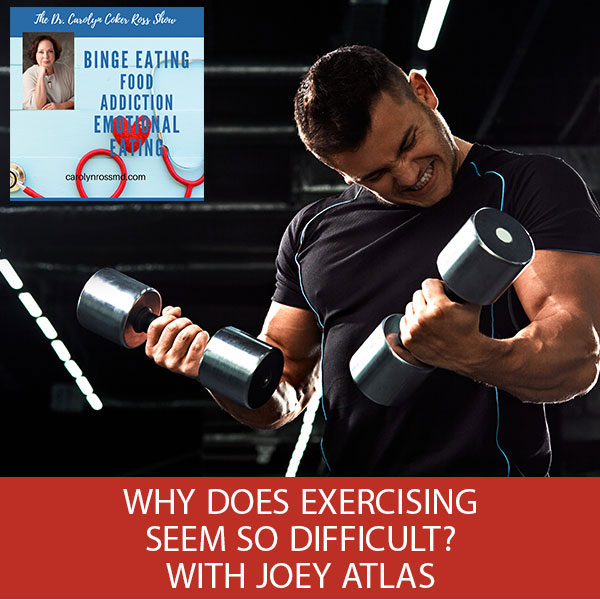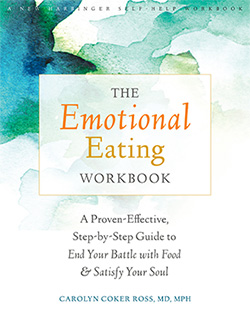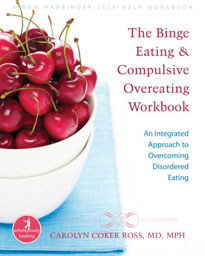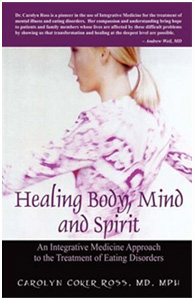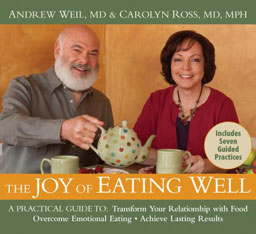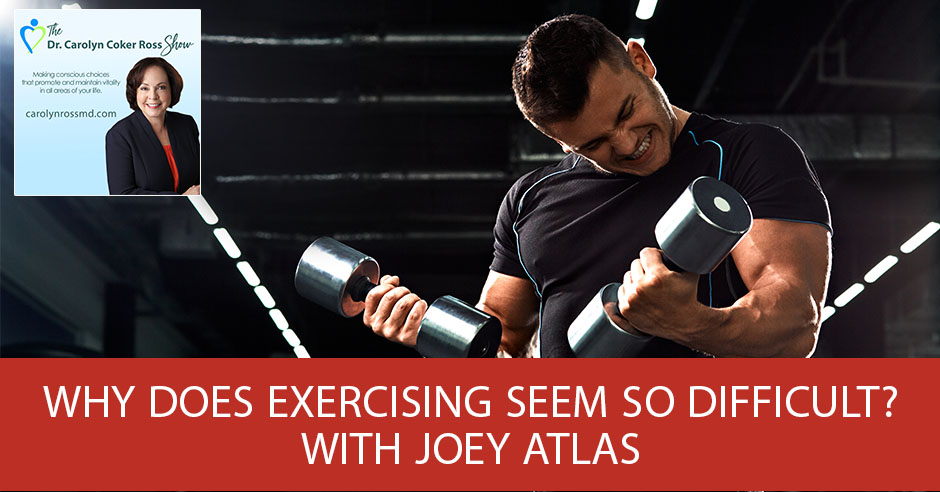
Joey Atlas shares his struggles with food as a child and then later as an adult competitive bodybuilder. Teased about his weight as a child, he found that sports enabled him to get in better shape but also started him on a downward spiral of food restricting alternating with binging. Over time, he realized he needed a more sustainable way to manage his carbohydrate and chocolate cravings without depriving himself of the foods he loved. His approach involves making exercise no different than it was when you were a child playing on a playground and making it more “efficient” so that anyone, no matter how busy, can get and stay fit. Joey shares his proven techniques which have helped hundreds of people learn to enjoy exercising again, enhancing their health, energy and fitness.
—
Watch the episode here:
Listen to the podcast here:
Why Does Exercising Seem So Difficult?
I’m here with Joey Atlas. He is an amazing fitness advocate, an expert. I’m going to be talking to him about everything you need to know to make your exercise doable and sustainable. Welcome to the show, Joey.
Thank you, Carolyn. It’s a pleasure to be here.
Tell us a little bit about how you got into the fitness world.
I had the privilege of being in a household where my father was into exercise and taking care of himself from a physical fitness aspect. Back in the early ‘70s, that was very uncommon. Looking back, I feel privileged to have had at least one parent who was into it and that made a very big impression on me.
Did he teach his kids?
Yes. He didn’t force it on us. He simply led by example. When we showed interests, he would then do more with us. When we showed interest, he would set up some little weights. He would set up little body weight exercises we could do that were easier versions of the things he was doing around the house. He fueled the natural interest we were showing. He never forced it though. It was very natural.
That’s an important point because so many parents don’t know whether to push their kids into exercise and so many kids are being signed up for multiple activities. That’s how you got started. It sounds like a good start in life, but it’s like at some point you didn’t carry through with that.
Seeing him and even at a young age, it was very obvious that this effort that he put into taking care of himself, set him apart from everybody else. It wasn’t aesthetically or superficial or for vanity reasons. You could see that his life was easier. He had a happier attitude. He was more pleasant to be around. He was stronger, he was usually healthier. Seeing that compared to everybody else that did something for me. It was more than the physique aspect of exercise. It was for the holistic benefits that were visible in observation and that did something to me. That fueled me from an early age to pursue that path, at first for myself. The challenge was I was also part of an Italian household where food was life and more food is more life. That combined with my natural tendencies to overeat and rely on food for more of my happiness turned into a problem for me. It was a very tough paradox that I lived in as I went into my late teen years and early twenties. I placed health and fitness as a priority in my life, but I struggled so much with the nutritional aspects not because I couldn’t eat healthy, but because I wanted to eat a lot of other foods in addition to eating healthy.
Did that lead to some problems with your weight or what?
It did. I struggled going into college with controlling my eating so that my fitness could be where I wanted it to be. The exercise wasn’t a problem because I had plenty of time at that stage of my life. It was only school, some work and working out. The food part was where I struggled. What happened was early in college, I started hanging out with a more of a health and fitness crowd. Some of these people would compete in bodybuilding competitions, which is something I had never done yet. They all saw something in me. They were very encouraging and saying that even though I was just a teenager, I should try to compete in the teenage classes. I loved the idea, but I knew the struggle was going to be the food part and not eating all the foods I love to eat.
I realized that had severe emotional connections to food, but I also saw it as an opportunity. I saw it as an opportunity to try to overcome some of those emotional attachments to all these great foods that I’ve become accustomed to eating and usually eating in too high amounts. I embarked down that path. My goal was to compete and win. That goal of competing to win was stronger than my desire to eat all those rich, awesome, tasty and delicious foods that I loved so much. It was only for a short amount of time that I had to give those up. It was doable.
It was almost like being on a diet then.
It felt like it. It was hard, but I was able to do it. Even though it was a struggle, it was something that would become a learning lesson for me to apply later in life.
[bctt tweet=”Don’t be like everyone else…be fit!” username=”CarolynCRossMD”]When we talked before, you mentioned to me that when you were in your late 20s or early 30s, that the weight did get the best of you. How did that feel for you reflecting back on the picture you had of your dad being so strong and fit, then here you were overweight and not as fit?
By my early 30s, I was already in marriage number one. We had plenty of dysfunctions. Some of them revolved around food and my weaknesses with food. The circumstances caused food to become my main crutch, my main drug. I probably started eating more than ever at that stage of my life and my weight started to get up there. For a guy who’s only 5’2”, getting into the 160s toward 170 was very painful. I had never been that high in my life. Not only was it physically painful, but my medical profile and my vitals were starting to show signs of decaying internal health as well. My triglycerides were bad, my glucose levels were bad and my blood pressure was getting worse. My cholesterol ratios and the total number, everything was getting worse. That should get worse when you gain a lot of weight. That was all happening. Things got to a point where I realized, “I know I have issues but now I need to start doing something about them.” When things got painful and scary, that motivated me to pull back and start taking control any way I could. It made me realize what was going on here. I was self-destructing. I had two young kids to live for. I still had a lot of life ahead of me. I didn’t want to let the dysfunctions of my external life and the internal battles of myself caused my self-destruction. I started becoming much more mindful, much more self-aware.
I reflected back and I remember phases in my dad’s life as well, where he wasn’t always perfect. He had phases in his lifetime where his workload was beyond normal. His outside demands were beyond normal. He was taking side jobs because he was in high demand and his exercise routine would take a backseat for an amount of time. Being in the Italian household we were in and his love of eating would get the best of him as well. He would get out of shape. He wouldn’t get dramatically overweight, but he would get out of shape. What I was able to see was when he got like that, when it was bad enough, he realized he had to change things up to get back to his normal. What felt good to him and the way he liked to live life. Reflecting back on that, I realize that we’re all human. We all have these ranges in our life and some of us are self-aware enough that when we get too far off center, we know what to do and how to think in order to get back to center. I knew I had that within me and that’s when I started reeling things in my early 30s knowing how much worse they could get. I didn’t like the prospects of things getting worse than they were and that woke me up.
I want to put in a little bit of a comment about weight in-house because we know that there are many people who can be overweight and still be metabolically healthy. That doesn’t necessarily mean your cholesterol will go up and your triglyceride. I don’t want to leave that impression because fitness is one of the best ways to stay healthy no matter what your size is. I want to segue now to talk about how you got into this whole notion of making exercise more fun, more available and more accessible starting with exercising on the playground. Can you tell us a little bit about how you got to that?
Part of the struggle in my early 30s when I was going through that tough phase was being a dad, having young kids and having a business. I have other demands and responsibilities in life that were not present in my early twenties. The demands of your schedule are different. Your time gets tighter. You’re required to do other things. I realized I’m trying to do my fitness in a way that I used to do when I was in my twenties and this isn’t fitting anymore.
When you could go to the gym and stay there for an hour and a half to two hours, if you want.
Beyond that, that style of working out was feeling counterproductive to my results and my body. My joints were hurting, my back was hurting, my elbows were hurting and my knees were hurting. I did not feel good as a result of my workouts. That’s the whole point of exercise is to feel good.
In the diet world, the point of exercise is to give yourself the privilege of eating. Some people feel like they have to trade off food by exercising so they can eat and that shouldn’t be the case. It should be enjoyable.

Exercise: I still had a lot of life ahead of me and I didn’t want to let the dysfunctions of my external life and the internal battles of myself cause me to self-destruct.
I realized, “I have to change this somehow.” I started to think back about how my dad used to train around the house or when we would go on vacation, he would find a playground. Some of the things and the pictures he used to show me from when he was in the military here. Then going to my education of exercise physiology and biomechanics of the body, I started doing my own workouts on a lot of local playgrounds and leaving the heavyweights and hardcore stuff behind.
Why did you pick the playground?
If you look at most playgrounds these days, if you look at them a certain way, you realize you can do so many exercises on a typical playground. If you look at it a certain way and you move your body in relation to gravity with all the variations, you have available to you. You can work every muscle group as deeply as you want to if you move properly. Which for me, having the biomechanics background through exercise physiology, it made me see things very differently than the normal person would see when they look at a playground. How a body could move on all the different pieces and parts of a playground.
Did it also seem to you from your mind that it might be more fun?
Absolutely. I love being outside and in certain climates and locations and when the weather was right, you could workout outside on a playground. That was beautiful. It was enjoyable. I could travel and all I had to do is find one playground. Usually, you can find more but you could get your workout outdoors in less than 30 minutes. Not only was it gentler on my body, but the training sessions were much shorter, which means I can fit them into my schedule now. Thirty minutes as opposed to 90 minutes is very different when you’re a busy adult. It was more fun and my body was feeling better. My joints were not hurting anymore. My back was not hurting anymore. I didn’t have these bouts of tendinitis and joint aches. For that reason, it was enjoyable because the pains were going away. All that to boot, the results were getting better because I was able to do this more consistently for way longer periods of time. When you do that and you’re eating decently, then your results start to compound and you start to see and maintain changes.
[bctt tweet=”Fitness is one of the best ways to stay healthy no matter what your size is.” username=”CarolynCRossMD”]Were you at all embarrassed that you were out there with the little kids?
No, I loved it because when there were people around, the little kids would look at me like, “Look what this dad is doing.” They would say to their parents, “Mom and dad, why don’t you do this too?” Some of them would say, “I’ll do it.” I would teach them. I would show them. I love sharing. I love teaching other people the example. Some people would say, “No, I don’t work out. I’m just going to sit here on the bench.” It was a lot of fun seeing what the different reactions would be from different kids in different parents and grandparents. The way I see life is I’m here to inspire people and lead by example. If that means setting this great example on a playground that is outside the norm, then that’s what I’m here to do. It benefited more people than it hurts. It still works to this day. I still do it.
When I travel, I usually look for playgrounds to work out on and I looked to set that example. These days what’s cool is that people will ask me, “How did you start thinking about doing this? You’re not young anymore, but you’re in awesome shape. You look healthy. How did you think about doing this? How can I do more of this?” What’s great is that I can share my YouTube channel. I’ve got playground workouts on the YouTube channel and people can go and follow them for free. I feel like I’ve helped somebody in society, especially young parents. Young parents have their hands tied. You’re raising children, one of the places you’re going to most often is the playground. What if every time you go to the playground, you can also get your physical fitness in? How cool is that?
It’s a genius idea. One drawback I can see is the weather because you’re on the East Coast and in the winter, it couldn’t have been too much fun working out on the playground.
You are dead on correct. The weather was a problem.
I know that you created a solution to that. Before we get to talk about your solution and how wonderful it is, I like you to talk a little bit more about the principles that you use in the exercise. You said exercise should be enjoyable. What other things do you see that works when we’re thinking about helping people start an exercise program or maintain an exercise program?
Some of the key principles are quite contrarian to what’s in the mainstream right now. In the mainstream you see this push toward high intensity, fast movements, no pain, no gain, you’ve got to push hard to get your body to change. You have to do this muscle confusion stuff. The truth is, instead of complicating things and making things more grueling and painful, the way people stick to something is if you simplify it and make it more enjoyable and gentler.
Enjoyment and simplification are important.
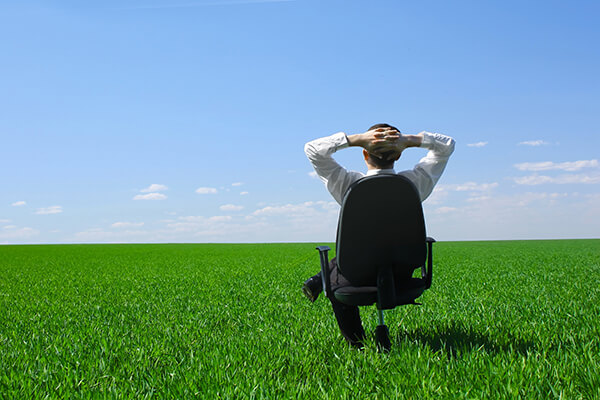
Exercise: Simplicity is what people remember more than complexity.
We as humans generally don’t like pain. We don’t like punishment. We don’t like self-torture. You can’t do those things that are expected of you on a daily basis if that’s what your fitness program is calling for because then we want to quit. Most people do because nobody wants to be in pain again on Wednesday and Friday and Saturday or whenever it is. Principle-wise, how do we remove that? The way to remove that is moving the body in a much slower manner through natural movement patterns. When you move the body more slowly through exercise movements, you remove the element of momentum as opposed to fast movements, which take advantage of momentum.
For example, the kettlebell swings terrify me because of the momentum issue. How easy it is in my mind that you could hurt yourself like that.
Most of the crowds that are doing are your Millennials. You’ll also have some people in the slightly older age ranges trying to hang onto their youth through intense exercise. The injuries, they speak for themselves. Orthopedists, chiropractors, physical therapists, most of their patients are coming from these high-intensity exercise programs and classes and regimens. I don’t even think I ever touched a kettlebell in my life. We talked about momentum. You do a kettlebell swing or something along those lines and once you get a weight in motion and you’re moving quickly to complete that motion, the momentum you achieve by moving that item through space is doing the movement itself. Now your muscles are guiding it and then they’re stopping and slowing it down and then in opposite direction again. Momentum and then stopping it and slowing it down. That does increase the risk of injury by nature of how you’re doing those movements.
Our joints take the brunt of starting and stopping those movements. The muscles are prone to tear and strain in those types of movements as well. Those are the most common injuries that happen. Joint injuries and muscle tears and strain. Here’s the cool thing, when you remove momentum from any movement of exercise, what happens is your muscles or muscle that you’re using for that particular movement has to engage itself to complete that movement because momentum is not doing it for you anymore, so the muscles have to do it. Now you have more muscle fibers being recruited to perform a certain body movement because you’ve taken out momentum and fast dangerous movements. You’ve reduced the risk of that exercise dramatically and you increased the safety dramatically. At the same time, you reduce the number of repetitions you have to do because each repetition is giving you a deeper, more thorough stimulus of the muscle and the muscle fibers in that muscle for that particular repetition. Instead of fifteen, you may only need seven or eight.
I don’t want to get too technical here, but what are your clients saying about how you’re teaching them to work out?
[bctt tweet=”The whole point of exercise is to feel good enough in the diet world. It is to give yourself the privilege of eating.” username=”CarolynCRossMD”]It depends where they’re coming from. Contextually, I may have a veteran fitness pro who’s also taking care of themselves as well. They might be in their late 50s or early 60s. They might have three or four certifications. They were a trainer in their younger years. They still do a little bit of training and on the other hand, I may have a completely sedentary person in their late 40s who maybe dabbled in a couple of aerobics classes twenty years ago. This is all contextual. What they’re saying, for example, the person who has a very deep fitness background, certifications and has trained people is very surprised. That this little known contrarian-type of unconventional exercise is making them feel like they’re working out so much more effectively. As compared to the HIIT style of boot camp training and heavy weight throwing that they were doing. Some of them are surprised, some will even admit they’re slightly embarrassed. They come with honesty. For me, I don’t care how they feel. What I care about is that they learn and they’re open to it and now they can take that to other people.
What about the sedentary one?
The sedentary people are surprised because in their head they’re thinking, “I was seeing on TV and I was reading in the magazine that this HIIT training is how I have to get the belly fat off. If I’m not raising my metabolic threshold through the roof, then the fat’s not going to come off and my body’s not going to change. It doesn’t make sense. You’re doing the opposite, but I’m feeling like I’m getting safer and more stimulation through this slower, more controlled, more enjoyable way of exercise. How is this possible?” For them, it’s very confusing.
I explained that the mainstream is the mainstream. There’s a lot of momentum there. There are a lot of advocates. There’s a lot of energy behind all of that. Just like any other industry, you’re always going to have this little unique group of people who are doing something different out of pure necessity and need because they couldn’t do the other stuff. They still had to find their way and this is how we’re doing it. We’re teaching it to people exactly like you who maybe had a back injury when they tried a cross-training class or maybe you tore your shoulder when you were doing a high-intensity boot camp. Maybe you dislocated your knee when the trainer was having you do hack squats with the plates loaded on each side.
We talked about simplicity and enjoyment. You also mentioned time efficiency. Getting the same results with less time and also, it sounds like less injury. Is there anything else that’s part of your principles about exercise that our readers need to know about? Or have we covered that?
There are a few of them and this might be the most important. When we talk about simplification, when you turn kids loose on a playground, they don’t need instructors to tell them how to go run and play in a playground. Nobody has to worry if they’re overdoing something too much, if they’re going up and down the slide too many times, if it’s going to create some imbalance. This is nature. The way I approach fitness training and I coach clients to approach it is don’t be so dogmatic. Even with my methods and approach, you don’t have to be so dogmatic. The key is to be consistent and naturally varied as the days and weeks and months progress. There’s enough variety in what I do and what we teach at the studio and what I teach clients long distance where even without equipment, if you’re in your own living room with your own body and a mat.
There’s still so much variety you can employ if you know how to move your body in relation to gravity and the way the body is designed to move. We don’t have to get complicated about it. We don’t have to journal every single movement we do and make sure we’re not doing too many of those next week. Movement is natural sample. Keep it simple. Keep it varied. Don’t over stress about trying to do too much of one thing or not doing too little of another. The key is to keep moving, enjoy what you’re doing and find variety. Always go back to the things you enjoy a lot, but don’t be afraid to try new things as long as they’re based on the same principles of safety and natural body movements.

Exercise: Don’t overstress about trying to do too much of one thing or doing too little of another. Know that the key is to keep moving and to enjoy what you’re doing.
You’ve now created a machine to replicate what you’re doing on the playground so people can do it year-round. They don’t have to be out on the playground in the snow. I understand that you had a machine that’s been out for a while and now you just come out with a new machine. Can you say a little bit about what the advantages that machine offer?
The advantages are we get to do everything we were doing on the playgrounds indoors in one spot. That’s the simple answer. Back when I was doing my playground training, I also had some clients who wanted to train on the playgrounds when the weather allowed. They loved it. It was awesome. It was fun and it was worth it to them. The problem was, in Florida, it can get hot sometimes or it can rain like crazy. Then if I was traveling or what have you, it was too cold for either me to work out outside. This notion of bringing this experience indoors was what sparked my desire to start sketching out what this thing could and would look like if it existed indoors. My clients were encouraging me that if I could figure this out, I may be onto something big.
I didn’t care about that. What I cared about was I want to bring this experience indoors for me, my kids and my clients who want to train with me. Because then we have our solution indoors, not outside anymore. We can go outside when we want to, but it won’t stop us when the weather prevents us. That was about twelve years ago. I made the first prototype after designing it and as the years progressed, it became very evident that I need to bring this out to the world. A lot of people wanted it and would benefit from it. That’s what we’ve done in the last few years. We opened the studio with a full line of the new machines in there and now we’re also selling the latest version of the machine to end users at home all over the world.
It’s amazing that you were so passionate about and you took it so far.
I didn’t foresee it back then. I wanted one to have. That was it. It’s having people reach out and seeing your videos and the information you’re sharing and them saying to you, “Will I be ever be able to buy one of those? I want one because I want to do exactly what you’re doing.” Then the wheels start turning and again, it’s not about money. This is about realizing that I created something that didn’t exist out of necessity and other people want this too. I started feeling the responsibility and the obligation to find a way to get it into their hands as well because they saw the value in it for them and their families.
Let me ask you one question. I worked with a lot of people who have food and body image issues. Some people who are living in larger bodies and aren’t happy about that. What’s been your experience? I know you yourself was able to get back to your fighting weight, so to speak. What’s been your experience of using this approach with someone living in a larger body?
[bctt tweet=”In life, know that the key is to keep moving and enjoy what you’re doing.” username=”CarolynCRossMD”]I have clients that want to buy one who they’re very overweight and I’ll tell them straight out, “This isn’t for you right now. There’s still so much you can do without this that you don’t need it yet.”
You start them more on a floor exercise program and I know you have a lot of videos and you’ve given us a link to some of the videos that are online for free. Your recommendation is get started with something like that. When you get a little more progressed to think about the machine.
If we’re going to assume somebody is carrying way too much excess body weight, there are still plenty of roads to cover without any equipment or even the most minimal of fitness accessories like a matt and a ball and maybe some resistance bands. It can give that person everything they need for at least a few months, maybe a year or so in order to start building their fitness foundation. Get the excess weight started to come off. Recondition their body and get it to a point where maybe they can consider putting one of these systems in their home for them and their family to continue that journey on. That’s the long-term view.
One of the things I also wanted to ask you is how do you deal with the fact that so many people who are living in larger bodies have had real exercise trauma? There are coaches who told them they’re too fat to do this or they shouldn’t be doing that. Does that come up with some of your clients?
It’s probably 90% something because most of these people have tried traditional mass market approaches to forcing the weight off. You can’t force the weight off with these types of approaches that are out there. When you take a commonly educated trainer or certified trainer or a fitness instructor, they’re going to try the forceful approach. We’re going to make your body get rid of this weight by forcing it to exercise and all they know is what they know. We have to give them that.
They are well-meaning.
They are certified and there are some great ones out there and excellent ones. Generally speaking, most of the experiences out there by people who are off center are negative experiences. It’s more than just the physical aspect and following a routine. It’s more so the psychological and mindset aspect of change that needs to be focused on and dealt with first, if not for the most part, before that physical foundation starts to get put in place in a very serious way. The trauma is not so much physical, it’s both physical and psychological. When you try to demand an unrealistic performance from somebody who’s trying to reach goals. They can’t live up to that on a realistic performance on a day-to-day, week-to-week and month-to-month basis, they get very frustrated. They get very down on themselves and it’s so easy to give up, which is what most people do. It was too grueling. It was too demanding. It was too unrealistic. It was too painful. If I don’t come out right and say that and that I’m stopping, I’m going to find life excuses to give me the out from that situation.
“I’m too busy. I don’t have the money,” etc. I was also referring to people who have had more direct emotional trauma. I’ve had patients who have had coaches or trainers who have said, “You can’t stay on the team because you’re too fat,” or who have made public comments about someone’s weight that’s very shaming and so on. Do you see that as well?
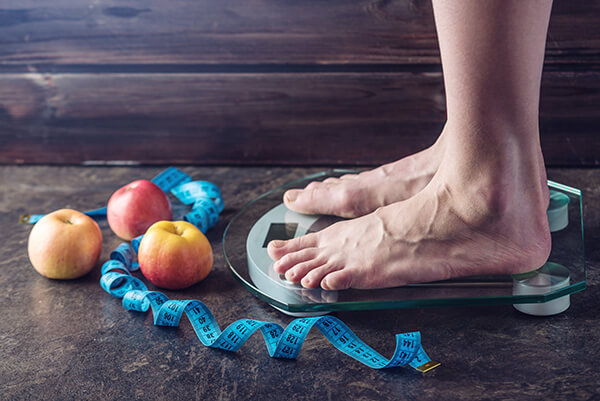
Exercise: Being healthy is more than the physical aspect; it’s also the psychological aspect of change.
I’m not laughing at the situation. I’m laughing at what the person did and where their mind was. Occasionally, I’ll go to a regular fitness center or gym when my son is back in town from college and he wants to bring me along and we’ll go spend some time together. I’ll observe some of the trainers and fitness instructors working with different people. I like to make mental notes and see what’s going on in the industry. Even if it’s in a very specific place like that, it gives me a good handle on some things. I remember seeing a trainer working with a client. Their definite goal was weight loss. The client couldn’t do the ten repetitions that they were being asked to do. It was maybe four or five and the trainer was yelling like, “I need you to do ten. You can’t stop at four. You’re slacking or you’re being lazy,” or something along those lines. This person I was watching could clearly not physically do it. They were not being lazy, they were not slacking. They physically could not do another one of those movements. The trainer didn’t have the depth to empathize with that person and realize that person can’t physically do another one. It’s not being lazy. They’re not just quitting. They’re not just giving up. They could not physically do it. I don’t know where the trainer was coming from in saying that you’re giving up, you’re quitting, you’re being lazy as opposed to saying, “That was awesome. You did four. That’s perfect.”
“Let’s shoot for five next week.”
That’s a totally different experience on the client side of things. When they get the experience and told that they’re being lazy, they’re quitting, they’re giving up, they’re most likely going to quit and give up when they feel like they’re being judged like that with inappropriate measuring guides. That trainer is not being open enough to seeing where this client is and that they are giving it their all. Maybe because the trainer asked for ten and they only got four, maybe the trainer felt like they’re coming up short and they’re going to take it out on the client. We don’t know, but still the end result is still the same. That damages more clients than it does good and that’s one example. There are so many variations of that type of episode that damage various clients and make them want to stop that program or that routine or seeing that trainer or what have you. It has to change. There has to be more compassion. There has to be more empathy. There has to be more of a nurturing style of guidance that is employed in the fitness realm especially with people who are challenged.
They need to dispense with the one-size-fits-all. The whole diet industry is all about you find this one diet and then you’re going to be successful and it never works. We know diets don’t work. You apply that same one-size-fits-all in the fitness industry where everybody’s got to do ten. If you don’t do ten, you’re failing. That’s what I see a lot in my work with clients is that they’re so turned off to exercise because they had these negative experiences.
You mentioned something about the diet aspect. When I coach people, when we first start, whether it’s local or long distance, one of the first questions they’ll ask is, “What kind of diet am I going to follow?” I’ll say, “You’re not going to be going on a diet.” They’ll say, “What do you mean? I don’t get it.” “You’re not going to have to diet. We’re still going to talk about things and we’re going to talk about proper nutrition. We’re going to talk about why you make certain decisions and eventually you’re going to start to realize that you never needed to be on a diet. You don’t have to go on a diet. You’re going to realize that you have to start thinking certain ways and learn a few things and your diet, your nutrition is going to start to take care of itself through this process.
[bctt tweet=”True change starts with the mindset.” username=”CarolynCRossMD”]It’s the difference between coming at it like people come at exercise only to lose weight and then once they’ve lost the weight, they stop exercising. The same with food programs. People go on a food program, but then once they’ve reached their goal or they can’t do it anymore, they throw it out the window. The most important thing is that sustainable quality and that’s what I like about your work with exercise. It sounds like having something that’s fun that doesn’t take too much time. Even that you can do in your own home and have fun. It might give people an entree back into the world of fitness, which is super important for health reasons, no matter what your weight is. There are plenty of thin people who are not healthy because they’re not active. They’re sedentary. It’s super important to be active to help with your blood pressure and all of those things.
We have at the studio and people I work with either local or long distance, I tell people, “It’s okay if your weight doesn’t even change because we still have to get your balance to be better.” We still have to get your muscle metabolism to be better so that you can prevent diabetes. We still have to get your bone density better.
To prevent osteoporosis exactly.
We still have to get your range of motion better. There are all these things that can improve without any change in body weight.
All of those things can make your quality of life so much better. If your joints aren’t hurting you and if you’re not feeling shame about your weight in the gym, you’re much more likely to be active.
You can improve your energy which can improve your mental acuity. There are so many benefits that can come without losing a few pounds or any pounds with proper exercise. It improves your entire life. You get to stay out of a wheelchair much longer. You get to be independent for a few more decades instead of people having to spoon feed you. It’s so simple that it’s doesn’t hit home for some people to look down the road and think, “What can these strengthening and flexibility benefits bring me? If I make the investment now, how will those benefit my life in 20, 25, 30 years?” When they can grab that future vision and realize that if they have their strength, their balance, their mobility, their mental acuity, that they’re going to have still have an awesome life down the road.
From you and my standpoint being over 40, you don’t realize how fast it all goes. I want to ask you to give people a resource where they can find out more about you and if they want to contact you, what would be the best way?
There are a few ways and everybody has their personal preference. One, I’ve got a bunch of great free videos and the shortcut link, you can go to JoeyAtlas.com and you’ll see the free Fit for Life Program link. Just click that link. They can get the free two weeks of videos. All my social media links are at the bottom of that site and I usually do some stuff on Facebook Live. I’ll do some things on my YouTube channel. Maybe once or twice, sometimes three times a week I’ll upload some new videos into YouTube. Sometimes they’re how I’m working out. Sometimes it might be some mindset material. How I overcame certain obstacles and how other people can use the same lesson. Sometimes it’s a mixture of random things that are helpful for different people at different stages of life. Those are probably some of the best places to see what I’m putting out there, benefit from some of it and then maybe even connect with me if that’s what they want to do.
Joey, it’s been a pleasure talking with you on the show. I enjoyed it.
Thank you for having me.
You’re very welcome.
It’s a pleasure to be here. Thank you.
Important Links:
- Joey Atlas
- Facebook – Joey Atlas Page
- YouTube – Joey Atlas Channel
- http://OptimumFlexibility.com/
- http://LegButtHipThighExercises.com/
- http:/JoeyAtlas.com/
About Joey Atlas
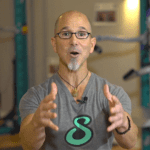 Challenged by a tendency to gain fat easily and an early obsession with food, Joey’s desire to become fit, lean and strong led him to an education and career in fitness. When his “baggy drawstring sweatpants” didn’t fit anymore, he knew it was time to take control. From that day on, Joey realized the secret to permanent fitness success lies within the mind more than anything else.
Challenged by a tendency to gain fat easily and an early obsession with food, Joey’s desire to become fit, lean and strong led him to an education and career in fitness. When his “baggy drawstring sweatpants” didn’t fit anymore, he knew it was time to take control. From that day on, Joey realized the secret to permanent fitness success lies within the mind more than anything else.
One of his main mantras is that fitness success is basically guaranteed when the fuel for motivation comes from one’s own values – values that are built on the desire to get the most out of the gift of life by living a fitness lifestyle. According to Joey, logic and common sense are two of the most important elements to maintain in your lifelong journey of fitness success. He reminds you that, “Fitness is not a thing that you do, but rather a state of being.”

